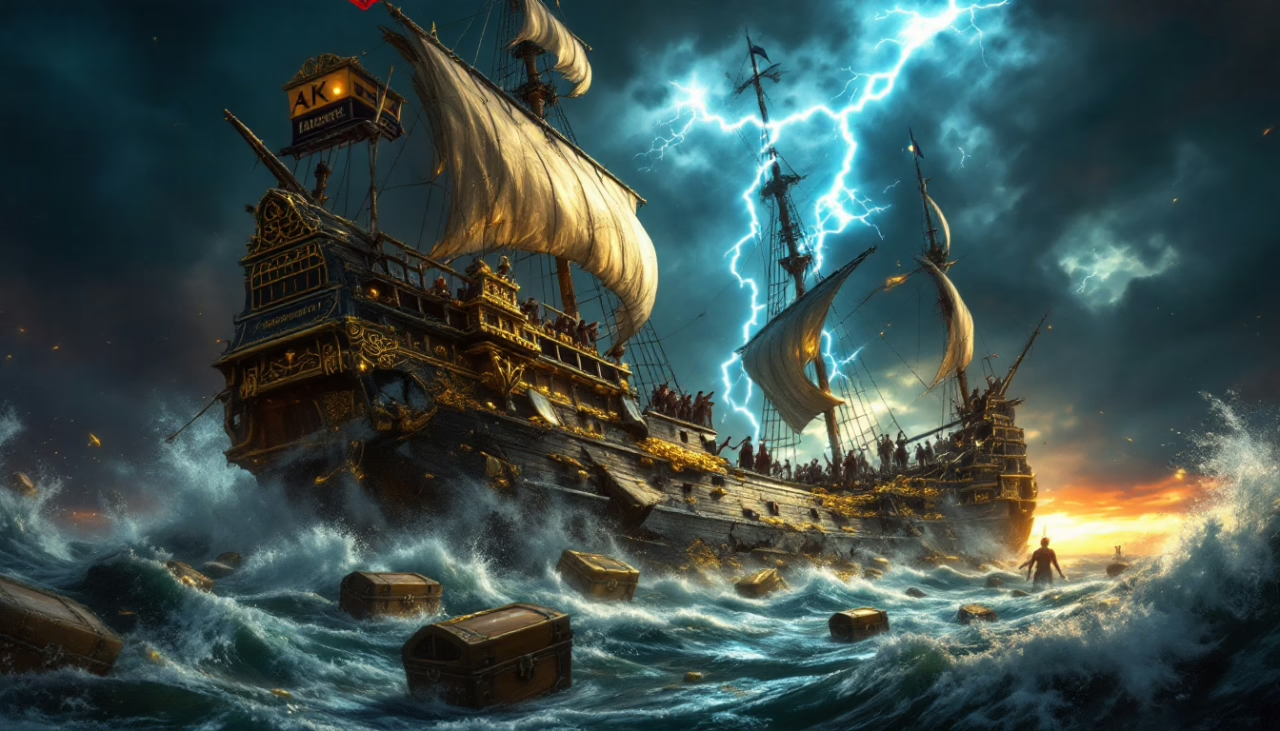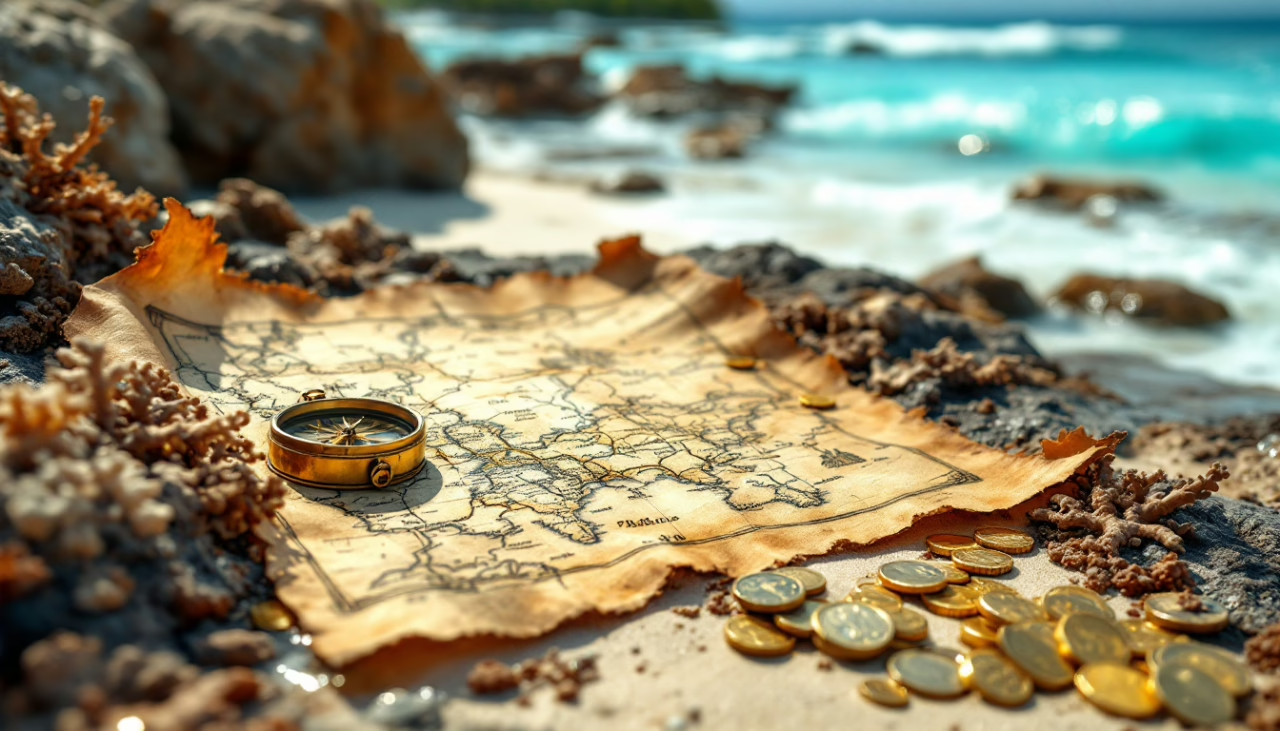The Lost Treasure of Flor De La Mar

Flor de la Mar: Ship of Gold and Storms – The Portuguese carrack Flor de la Mar represents one of history’s most tantalizing maritime enigmas.
Somewhere beneath the Sumatran waters lies a fortune—sixty tons of gold, precious gems, and artifacts—swallowed by a cyclone in 1511 after Captain Albuquerque’s conquest of Malacca.
Scholars estimate its modern value at several billion dollars, yet despite technological advances in underwater exploration, the treasure eludes detection.
The wreck inhabits that shadowy intersection where documented history meets legend, challenging contemporary treasure hunters to distinguish between verifiable accounts and embellished maritime folklore.
Highlights
Hide- Flor de la Mar, sunk in 1511, reportedly carried 60 tons of gold and priceless treasures worth billions in today's currency.
- The ship's cargo included Sultan Mahmud Shah's wealth, rare Malaccan diamonds, and ancient Chinese diplomatic artifacts.
- The wreck occurred during a violent tropical cyclone near Sumatra, with most treasure lost to the sea.
- Multiple expeditions since the 16th century have searched for the treasure, using historical accounts and modern technology.
- The legendary treasure remains undiscovered, inspiring ongoing debates among marine archaeologists about its preservation and location.
Flor De La Mar: A Ship of Power and Prestige

The Flor de la Mar, constructed in Lisbon in 1502 under Portuguese royal commission, emerged as one of the largest vessels in Portugal’s formidable naval fleet during the Age of Discovery.
Throughout her early voyages to India and Southeast Asia, the carrack’s imposing 400-ton displacement and substantial artillery complement established her as a floating fortress that commanded respect across maritime trade routes.
Her tactical significance extended beyond mere transportation, as Portuguese commanders frequently positioned the Flor de la Mar at the vanguard of naval engagements, where her firepower and imposing silhouette served both military objectives and as a potent symbol of Portuguese imperial ambition in contested waters.
The Construction and Launch of Flor de la Mar
The Flor de la Mar, constructed at Lisbon’s Royal Shipyard in 1502, represented a revolutionary advancement in Portuguese naval architecture that combined unprecedented carrying capacity with formidable defensive capabilities.
This magnificent carrack, whose name translates to “Flower of the Sea,” embodied Portugal’s expanding maritime ambitions during the Age of Discovery—a physical manifestation of King Manuel I’s imperial vision.
At approximately 400 tons, she stood as one of the largest vessels in Portugal’s armada, her imposing silhouette serving as a floating embassy of Portuguese power as she traversed the newly established eastern trade routes.
Built in Lisbon: A new breed of Portuguese carrack
During Portugal’s remarkable Age of Discovery, Lisbon’s royal shipyards bustled with unprecedented maritime innovation, giving birth to vessels that would fundamentally transform oceanic travel.
The Flor de la Mar exemplified revolutionary carrack design—featuring advanced naval architecture that balanced cargo capacity with defensive capabilities.
These shipbuilding techniques, refined through practical experimentation rather than theoretical speculation, represented Portugal’s commanding grasp of maritime innovations with profound historical significance.
Symbol of imperial ambition and maritime expansion
Grandeur and naval supremacy intertwined magnificently in the construction of Flor de la Mar, a vessel whose very existence proclaimed Portugal’s imperial aspirations to both European rivals and Asian kingdoms.
As a floating embassy of maritime heritage, the carrack embodied King Manuel’s colonial ambitions, its gilded hull and treasure symbolism communicating Portugal’s naval power across once-uncharted waters that now served as highways for European expansion.
Early Voyages and Tactical Importance
The Flor de la Mar, after her triumphant launch in 1502, quickly became an indispensable tactical asset in Portugal’s ambitious quest to secure maritime trade routes throughout the Indian Ocean.
Her formidable size and firepower enabled the Portuguese to establish naval dominance against both indigenous vessels and rival European powers, effectively protecting valuable spice trade networks while simultaneously projecting Portuguese military might across distant waters.
Despite these strategic advantages, however, the ship’s considerable draft presented significant challenges during her initial expeditions, forcing captains to navigate with extreme caution through the shallow coastal waters and treacherous reefs that characterized many Eastern trade ports.
First missions and role in naval dominance
Commissioned in 1502 under Portuguese naval expansion, the Flor de la Mar swiftly established herself as a cornerstone of Portugal’s formidable Armada da Índia.
Her maiden voyages demonstrated revolutionary naval tactics that transformed maritime strategy throughout the Indian Ocean.
As flagship of the imperial fleet, she conducted historical voyages that established Portuguese dominance while facilitating treasure hunting expeditions that would ultimately seal her legendary status.
Challenges faced on her initial expeditions
Despite her imposing silhouette and technological sophistication, the Flor de la Mar encountered formidable adversities during her initial expeditions that tested both vessel and crew beyond anticipated limits.
Navigation difficulties plagued voyages through uncharted waters, while unpredictable monsoons created perilous weather challenges.
Strategic miscalculations, compounded by critical supply shortages, eroded crew morale, particularly when Portuguese commanders prioritized territorial conquest over sailors’ welfare.
A Journey into Legendary Wealth
Following the conquest of Malacca in 1511, Portuguese forces under Afonso de Albuquerque systematically commandeered vast quantities of gold, silver, and precious gems from the wealthy sultanate’s royal treasury.
These spoils, estimated to be worth billions in today’s currency, represented not merely material wealth but Portugal’s triumphant expansion into the lucrative Asian maritime trade networks.
The treasure aboard Flor De La Mar symbolized a pivotal moment in colonial history—a transfer of power and resources that would have fundamentally altered Portugal’s standing among European powers had the ship completed its intended voyage to Lisbon.
The Conquest of Malacca and Accumulated Riches
Following the conquest of Malacca in 1511, Sultan Mahmud Shah‘s incomprehensible wealth—amassed over decades of strategic trading at Asia’s commercial crossroads—was systematically loaded aboard Afonso de Albuquerque‘s flagship, the Flor de la Mar.
Historical accounts, particularly Portuguese chronicles, describe the cargo’s opulence in reverent tones: coffers brimming with gold ducats and precious stones, ceremonial weapons adorned with rubies and emeralds, and Ming dynasty porcelain of such rarity that European royalty had never glimpsed its equal.
The vessel’s holds strained under the weight of this plunder, estimated by modern scholars to exceed $2.6 billion in contemporary valuation, representing not merely material wealth but the concentrated economic power of an entire sultanate that had dominated maritime trade routes throughout Southeast Asia.
Sultan Mahmud’s treasure loaded aboard the Flor de la Mar
Albuquerque’s monumental capture of Malacca in 1511 yielded not only a strategic maritime stronghold but also access to Sultan Mahmud Shah’s legendary accumulated wealth, a treasure trove that would ultimately find its way aboard the ill-fated Flor de la Mar.
The Sultan’s treasure—comprising cultural artifacts, precious metals, and ceremonial regalia—represented more than monetary value; it embodied centuries of maritime history and legitimized Portuguese conquest in narratives that persist today.
Descriptions of the cargo: gold, gems, and rare artifacts
The cargo manifest of the Flor de la Mar, as documented in Portuguese chronicles and contemporary accounts, reveals a collection of treasures so magnificent that it continues to tantalize treasure hunters and historians alike.
The maritime riches represented both Portugal’s imperial ambitions and Sultan Mahmud’s accumulated wealth of historical significance.
- Golden bounty estimated at 60 tons—equivalent to billions in today’s currency
- Precious gems including Malaccan diamonds and emeralds of exceptional clarity
- Ancient artifacts from diplomatic exchanges with Chinese emperors
- Religious reliquaries adorned with pearls from Indian Ocean trade routes
- Personal treasures of Sultan Mahmud, including his crown of unprecedented value
Why This Treasure Mattered So Much
The treasure aboard Flor De La Mar transcended mere monetary value, representing Portugal’s strategic foothold in the lucrative spice trade and its triumphant expansion into Asian markets previously dominated by Muslim merchants.
Portuguese chroniclers, including Tomé Pires and Gaspar Correia, documented the vessel’s extraordinary cargo—gilded furniture from the Sultan’s palace, ceremonial weapons encrusted with precious gems, and chests of gold coins—establishing its legendary status in both official royal archives and cultural imagination.
Beyond its economic significance, which would have funded further colonial ambitions, the treasure embodied symbolic power: tangible proof of Portugal’s ascendancy as a global empire capable of extracting wealth from distant territories and reshaping international commerce.
Strategic, economic, and symbolic value to the Portuguese Empire
Beyond mere material wealth, this legendary cargo represented an intricate nexus of Portuguese imperial aspirations that extended throughout the Indian Ocean trading system. The treasure’s multifaceted value encompassed maritime strategy, economic impact, and historical significance—a material manifestation of Portugal’s imperial expansion and geopolitical ambitions during the Age of Discovery.
- Strategic foothold that legitimized Portuguese dominance in Asian waters
- Economic leverage against Venetian and Ottoman trade monopolies
- Symbolic validation of royal investment in maritime exploration
- Tangible evidence of successful imperial expansion eastward
- Essential financial foundation for sustaining colonial infrastructure
Stories from chroniclers and royal archives
While Portuguese royal archives and contemporary chronicles seldom align perfectly in their accounts, they converge dramatically when detailing the staggering wealth aboard the Flor de la Mar before its catastrophic sinking.
Maritime history scholars note how these chronicler accounts, preserved meticulously in royal archives, have fundamentally shaped historical narratives surrounding the vessel, amplifying its cultural impact across centuries as both cautionary tale and treasure-hunter’s ultimate quest.
The Fateful Wreck off Sumatra
The ill-fated Portuguese carrack Flor De La Mar, sailing from Malacca with its unprecedented bounty in 1511, encountered a violent tropical cyclone while traversing the treacherous Strait of Malacca near Sumatra.
Battered by towering waves and hurricane-force winds, the overloaded vessel—structurally compromised from years of service without proper maintenance—splintered against previously uncharted reefs in the midnight hours.
Contemporary Portuguese chronicles indicate that while Admiral Afonso de Albuquerque survived by clinging to floating wreckage, nearly three hundred sailors perished in the catastrophe, their bodies and the sultan’s treasure scattered across the seabed in what would become one of history’s most tantalizing maritime losses.
The Route Taken and the Storm Encountered
Albuquerque’s decision to navigate homeward with the treasure-laden Flor De La Mar during the monsoon season of 1511 stemmed from political pressures to return the Malaccan spoils to Lisbon promptly, despite warnings from local mariners about treacherous conditions.
The Portuguese admiral’s hubris proved disastrous when the aging carrack, already compromised by structural weaknesses from previous voyages, encountered a violent tempest near Sumatra’s northern coast.
As monstrous waves and howling winds battered the vessel against submerged reefs in the Strait of Malacca, the ship’s wooden hull splintered catastrophically, consigning its immense treasure—and many souls—to the depths of the sea.
What led to the ill-fated decision to sail home during monsoon season
Despite warnings from experienced mariners and local officials, Afonso de Albuquerque made the fateful decision to navigate the treacherous Strait of Malacca during monsoon season in late 1511, a choice that would ultimately condemn the treasure-laden Flor de la Mar to its watery grave.
- Imperial urgency trumped monsoon navigation challenges as Portugal raced to secure Asian wealth.
- Crew decision making was compromised by Albuquerque’s authoritarian command style.
- Historical maritime practices lacked sophisticated weather prediction methodologies.
- The flagship’s structural weaknesses were overlooked in pursuit of royal glory.
- Local knowledge of seasonal patterns was dismissed as Portuguese hubris prevailed.
The violent weather that shattered the hull near the Strait of Malacca
Sailing headlong into danger, the Portuguese carrack *Flor de la Mar* faced catastrophic weather conditions in November 1511 that would seal its fate in maritime history.
The vessel encountered unprecedented storm intensity near Sumatra, where navigational errors led it into volatile weather patterns. Hull damage began when massive waves battered its aged wooden frame—a devastating reminder of maritime safety’s importance in an era when seafarers pursued freedom across treacherous oceans.
Aftermath and Rescue
The aftermath of the Flor De La Mar’s wreck reveals a stark dichotomy: while contemporary Portuguese chronicles indicate that Albuquerque and a portion of his crew survived by clinging to ship fragments, the vast treasure—secured in the vessel’s hold—vanished beneath the Sumatran waters.
These survivors, rescued by indigenous fishermen who witnessed the catastrophe unfold, recounted the horrifying spectacle of imperial wealth disappearing into the depths, where gold coins, precious gems, and ornate artifacts from Malacca’s conquest settled into the seabed.
The treasure’s disappearance transformed physical wealth into maritime legend, establishing what many historians consider one of history’s most valuable shipwrecks, its location remaining contested despite numerous expeditions and claims of discovery throughout the centuries.
Accounts of the crew’s survival
When the massive Flor de la Mar struck the treacherous reefs off Sumatra in November 1511, chaos enveloped the once-mighty Portuguese carrack, yet remarkably, numerous crew members survived to document the catastrophe.
Contemporaneous accounts illuminate extraordinary survival tactics employed during the maritime disaster.
- Albuquerque himself dictated shipwreck experiences while clinging to debris
- Crew morale strengthened through prayer and mutual assistance protocols
- Indigenous fishermen facilitated initial rescue attempts
- Hardship stories featured in Portuguese court chronicles
- Survivors dispersed across Malacca, Goa, and Lisbon
The disappearance of the treasure beneath the sea
While survivors clung to fragments of broken timber and whispered prayers for salvation, Flor de la Mar‘s fabled treasure met a drastically different fate beneath the tempestuous waters off Sumatra’s coast.
Maritime mysteries surrounding this immense wealth spawned countless treasure myths, yet underwater archaeology confirms the historical significance of this disaster.
The cargo’s dispersal across the seabed transformed tangible riches into enduring sea legends—material wealth transmuted into cultural inheritance.
Searches and Speculations Through the Ages
The quest for Flor De La Mar’s legendary treasure began almost immediately after its demise, with Portuguese authorities dispatching salvage missions that proved futile against the treacherous Sumatran waters.
Throughout the centuries, adventurers and treasure hunters, armed with little more than historical accounts and speculative cartography, conducted sporadic searches that yielded nothing beyond tantalizing rumors and dubious claims.
Modern exploration efforts, however, employ sophisticated technologies—including side-scan sonar, magnetometers, and remotely operated vehicles—offering unprecedented potential to locate the elusive wreckage that has confounded searchers for over five centuries.
Early Attempts to Locate the Wreck
Portuguese mariners, dispatched within months of the sinking, documented the first official attempts to recover the Flor De La Mar’s legendary cargo, though their expeditions were hampered by treacherous waters and inadequate salvage technology.
Throughout subsequent centuries, local fishermen and coastal inhabitants cultivated elaborate narratives about the shipwreck’s location, often embellishing details with supernatural elements that misdirected serious historical inquiry.
These misleading folkloric accounts, while preserving the shipwreck in cultural memory, ultimately confounded legitimate archaeological efforts by suggesting multiple contradictory locations—from the shallow straits near Malacca to remote islets in the Sumatran archipelago—thereby transforming a tangible historical event into an elusive maritime legend.
Portuguese recovery efforts in the 16th century
Immediately following the spectacular wreck of Flor de la Mar in 1511, official Portuguese recovery efforts commenced with remarkable urgency, reflecting the immense value of the lost cargo and its significance to the Portuguese crown.
Portuguese naval strategies evolved specifically to address such maritime disasters, creating specialized salvage protocols that integrated with existing trade routes.
- Documents from Lisbon’s Naval Archives reveal three distinct recovery expeditions between 1512-1519
- Salvage vessels employed innovative historical shipbuilding techniques including reinforced hull designs
- Imperial maritime ambitions drove these missions despite significant financial and human costs
- Local Malay populations integrated the shipwreck into treasure hunting folklore
- Recovered artifacts reportedly included ceremonial items but little of the documented wealth
Myths and misleading leads from local tales
Where fact ends and fiction begins remains notoriously difficult to discern in the centuries-old search for Flor de la Mar’s legendary treasures.
Local legends proliferated across coastal communities, blending maritime stories with cultural folklore that often contradicted historical records.
These treasure myths—featuring enchanted guardians and impossible riches—led numerous expeditions astray, their purveyors unwittingly perpetuating historical inaccuracies that complicated legitimate archaeological efforts.
Modern Exploration and Technology
The advent of sophisticated scanning equipment and remote-controlled vehicles has transformed the search for Flor De La Mar, with several international submarine expeditions and treasure-hunting consortiums scouring the Strait of Malacca since the 1990s.
These modern ventures, equipped with magnetometers and side-scan sonar technology, have yielded tantalizing anomalies on the seafloor that correspond to historical accounts of the shipwreck’s location.
However, the pursuit has been complicated by overlapping maritime claims between Indonesia, Malaysia, and Singapore, creating a labyrinth of legal challenges regarding salvage rights that has effectively stalled several promising recovery operations.
Submarine missions and treasure-hunting companies
Numerous deep-sea exploration ventures have targeted the elusive wreck of Flor de la Mar since the advent of modern submarine technology in the late 20th century.
These underwater archaeology missions combine cutting-edge treasure hunting technology with historical research, employing sophisticated salvage operations to investigate one of maritime history’s most tantalizing mysteries.
- Blue Water Recoveries’ 1992 expedition utilizing side-scan sonar
- Metron’s algorithmic probability mapping based on historical accounts
- Odyssey Marine Exploration’s ROV deployment near the Strait of Malacca
- Indonesian government-sanctioned surveys with magnetometer arrays
- Collaborative Malaysian-Portuguese underwater archaeological assessments
The legal and political conflicts surrounding the salvage rights
Competing international claims have transformed the Flor de la Mar’s potential recovery into a diplomatic minefield spanning multiple continents, with sovereign interests colliding over rights to what could be history’s most valuable shipwreck.
Legal disputes between Malaysia, Indonesia, and Portugal have intensified, complicating salvage rights under international treaties.
Political ramifications extend beyond treasure ownership, challenging maritime law‘s adequacy in resolving historical patrimony questions.
Treasure or Tale? The Legacy Today
The enduring legend of Flor De La Mar transcends maritime history, appearing in literature, film, and folklore across Portuguese, Malaysian, and Indonesian cultural traditions, where it functions as both cautionary tale and symbol of colonial hubris.
Modern investigators remain divided between those who consider the treasure a factual historical asset—supported by Portuguese royal inventories and contemporary accounts—and skeptics who question the extravagant valuations or suggest the cargo was salvaged shortly after the wreck.
This persistent ambiguity, oscillating between historical certainty and mythic embellishment, exemplifies how shipwrecks often occupy the liminal space between verifiable archaeology and the irresistible allure of lost wealth in our collective imagination.
Cultural References and Historical Echoes
The enduring mystery of Flor De La Mar’s treasure has transcended centuries to become a cultural touchstone across Southeast Asia and Europe, inspiring numerous books, documentaries, and sustained national interest in Malaysia, Portugal, and Indonesia.
Scholarly expeditions and amateur treasure hunters alike continue to reference the Portuguese galleon’s ill-fated voyage in their quests, drawing from historical archives while perpetuating the ship’s legendary status through modern media.
This persistent fascination reflects how maritime disasters of the colonial era evolve from historical incidents into entrenched folklore, where the boundaries between documented history and mythologized narrative remain tantalizingly blurred.
Books, documentaries, and national interest in Malaysia, Portugal, and Indonesia
Throughout decades of historical fascination, numerous books and documentaries have chronicled the enigmatic fate of Flor de la Mar, galvanizing national interest across three countries with competing claims to its sunken treasure.
Maritime history enthusiasts and governmental agencies alike have explored colonial legacy narratives, scrutinizing historical records for clues to this elusive shipwreck.
- Robert Parthesius’s “Dutch Ships in Tropical Waters” contextualizes the treasure within broader colonial exchanges
- Malaysian filmmaker Rakis Ahmad’s acclaimed documentary “Flor do Mar: Portugal’s Ill-Fated Galleon” (2013)
- Indonesia’s National Maritime Museum hosts permanent exhibits featuring replicas of artifacts
- Portugal’s Naval Museum maintains original manifests and correspondence detailing the ship’s final voyage
- “Treasure Hunters of the Straits” (2018) examines modern expeditions through critical postcolonial perspectives
How the ship’s story shaped treasure hunting folklore
Whether recounted in seaside taverns or portrayed in modern media, Flor de la Mar‘s legacy has fundamentally shaped treasure hunting folklore across Southeast Asian and European cultural narratives since the 16th century.
The shipwreck’s enigmatic fate catalyzed maritime legends that transcend mere historical narratives, embedding itself in folklore origins that reflect colonial ambitions, indigenous perspectives, and the universal human fascination with lost wealth and its recovery.
The Debate Over What Lies Beneath
Marine archaeologists remain divided about whether the Flor De La Mar‘s wooden structure could have survived centuries of submersion in the corrosive Strait of Malacca waters, despite numerous expeditions failing to yield conclusive evidence.
The collision of empirical limitations with the tantalizing possibility of intact treasure chambers beneath the seafloor creates a scholarly impasse that continues to fuel speculation.
This tension between verifiable historical record and persistent legend exemplifies how shipwrecks transcend mere archaeological interest, becoming repositories of cultural imagination where factual constraints collide with the allure of undiscovered wealth.
Could the wreck still be intact?
How much of the fabled Flor De La Mar wreckage might still remain after five centuries beneath the Malacca Strait remains one of maritime archaeology‘s most tantalizing questions.
Modern wreck exploration techniques and underwater archaeology methodologies suggest surprising preservation possibilities within this maritime mystery.
- Protective silt layers potentially shielding hull fragments
- Brass cannons resistant to seawater deterioration
- Treasure chests possibly sealed in oxygen-deprived compartments
- Structural timbers preserved by anaerobic conditions
- Artifact distribution patterns revealing final moments of catastrophe
The clash between legend and provable fact
Where mythology and material evidence collide, the Flor De La Mar stands as a quintessential case study in the tension between folklore and archaeological verification.
Legendary narratives flourish in the absence of definitive artifacts, yet maritime scholars remain divided on historical accuracy.
The ship’s cultural significance transcends mere treasure myths, embodying the intersection where maritime folklore meets scientific inquiry—a contested domain where evidence, not sentiment, must ultimately prevail.
Wrapping Up
The Flor de la Mar’s treasure, like a phantom beneath azure waters, continues to tantalize the maritime imagination.
Its sixty tons of gold—simultaneously everywhere and nowhere—illuminate the nexus between historical certainty and mythological construction.
While technology advances and explorers persist, this submerged fortune remains paradoxically preserved by its elusiveness, a proof of how the sea guards its most coveted secrets, beckoning yet defying humanity’s grasp.





